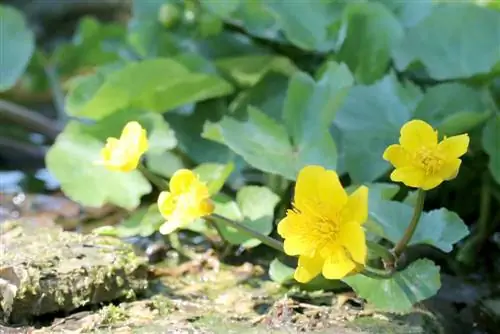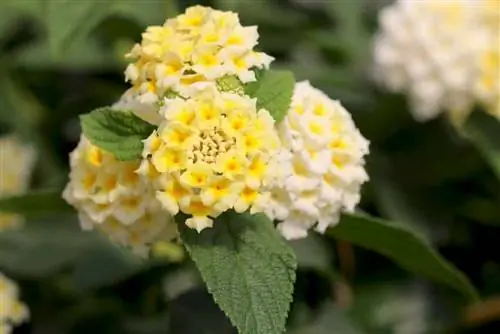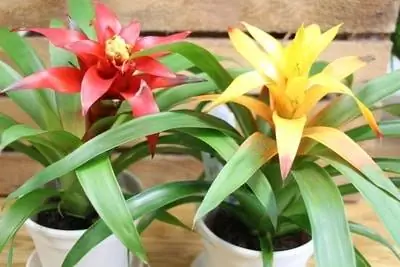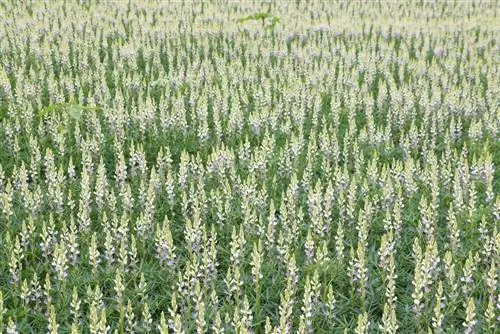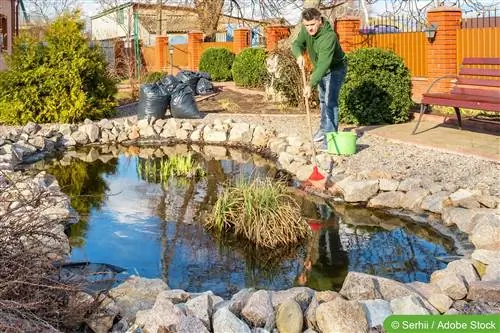- Author admin [email protected].
- Public 2023-12-17 03:39.
- Last modified 2025-01-24 12:45.
The plant, also known as cowflower, eggflower or marigold, grows perennially and perennially. Depending on the location, it can reach heights of 15 to 50 cm, but initially grows in width. As a result, it usually occurs in larger populations. The intense golden yellow flowers, approximately four centimeters in size, appear from March onwards. A second bloom may be possible between July and October.
Swamp marigold as a pond dweller
The marigold from the buttercup family is a completely uncomplicated pond dweller that makes the banks of ponds, wet meadows or bog beds bloom. It provides splashes of color that are visible from afar early in the year. It does not look particularly beautiful in groups of several plants. It can also be combined very well with other pond and bank plants from a wide range of plant genera, for example with juggler flower, swamp forget-me-not, water iris, false calla, bald cypress or cotton grass.
Their shiny, dark green and kidney-shaped leaves are also very decorative and rich in contrast. A collective fruit with up to eight so-called follicles forms from the withered flowers. They have the ability to swim, so that the marsh marigold can also spread by water.
Tip:
The cow flower is slightly poisonous in all parts of the plant and can cause skin irritation and eye irritation upon contact and with sensitive people. Therefore, it is advisable to wear gloves as a precaution when handling this plant.
Location requirements
The marsh marigold is best kept in stagnant or shallow waters such as the banks and shallow water areas of a garden pond or stream.
- It thrives best when roots are in wet or moist substrate
- Preferably in a water depth of about five centimeters
- Develops best at this depth
- However, it shouldn't be deeper than ten centimeters
- Cowflower wants to be in sunny to partially shaded places in the garden
- Upper shoot parts should always be above the water surface
- In dark locations with little light, formation of long, unsightly shoots
- Consequence is a misshapen growth
- This significantly affects flower formation
Tip:
If the soil is humus and, above all, moist enough, planting in a bed is also possible.
Soil texture
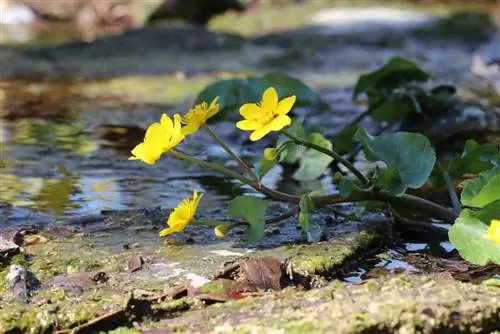
As far as the nature of the soil is concerned, C altha palustris prefers nutrient-rich, moist to swampy and heavy clay, loamy or peat soils. While some varieties prefer slightly acidic substrates, others feel most comfortable on calcareous substrates. A pH value of 5.8 to 6.5 is recommended.
Planting
Best planting time and soil preparation
The best time to plant marsh marigold is in both autumn and spring. This assumes that the water is not yet or no longer frozen and that no premature or delayed ground frosts are to be expected. Before planting, the planting area must be filled with a suitable substrate. To do this, you can enrich the existing soil with compost and, if necessary, mix it with clay or loam. Ultimately, the topsoil should be at least 20 cm thick, because if you plant the marsh marigold without a plant basket, it forms strong roots relatively quickly, which have to find support in the ground in order not to be washed away.
Planting
If you want to plant in a pond with fish, it is generally advisable to place the plants in a suitable plant basket and then, together with the basket, in the pond or shallow water area.
- Line the plant basket with some jute in advance
- Then fill with suitable substrate or special pond soil
- Then it is best to place the plant in the middle
- Fill with soil and weigh the whole thing down with pebbles
- Now place the basket in the right place in the pond or on the bank
- If there is no shallow water area, place the basket slightly higher
- For example, on a pile of stones or stacked stones
When planting both with and without a plant basket, ensure that the planting distances are sufficiently large. It is best to plant the cowflower in groups of 10-12 specimens each or small tuffs with 3-5 individual plants each. In between, planting distances of 25 to 30 cm should be maintained, because as already mentioned, the cow flower initially grows mainly in width.
Care instructions
C altha palustris is a very uncomplicated and easy-care plant that requires little care under optimal conditions. It tolerates even slight fluctuations in humidity without any problems. In order for the cow flower to thrive and bloom well for many years, a minimum amount of care is essential.
Watering and fertilizing
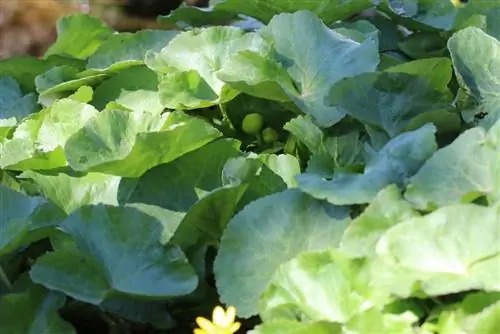
If the plant is in the bank area or the shallow water zone of a pond, there is no need to water it. If, on the other hand, it is in a moist perennial bed, it must be watered regularly so that the soil is always moist. Fertilizer can also be avoided when planting a pond. Fertilizer would do more harm than good here because it could, among other things, promote increased algae growth. Otherwise, it is advisable to give an organic fertilizer such as horn shavings or bone meal, but only in moderation.
Cutting
When cutting, the main aim is to prevent uncontrolled spread and, if necessary, to counteract infestation with mildew or rust fungi. Immediately after the first flowering, cut off everything that is wilted and dead. This cut usually results in the cow flower producing a second flower. In early spring, between January and February, the cow flower can also be cut back to just above the ground. Until then, leave the dead parts on the plant as they serve as winter protection. In the spring it will then sprout again reliably.
Wintering
Overwintering is also no problem, because the marsh marigold is hardy down to around -45 degrees. In autumn it pulls in most of its above-ground parts of the plant, only the root ball overwinters in the ground. As a result, no winter protection measures are necessary. When removing the dead parts of the plant in spring, you should be careful as the marigold has already put on new buds at this point.
Propagate
The marsh marigold can reproduce very well naturally, namely through seeds. In addition, they can also be propagated manually by sowing, but also via runners or by dividing the rhizome. The double varieties are an exception; they are sterile and can therefore only be propagated by division.
Sowing
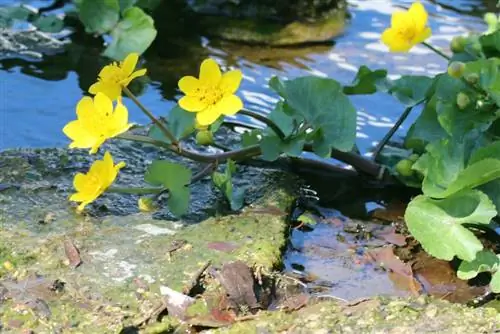
To get seeds, wait until the flowers have withered, because then the follicles with the brown seeds, which are up to 2.5 cm long, form. If these follicles dry out, they burst open as soon as they come into contact with water and release the seeds.
- Direct sowing is generally possible in summer or autumn
- Seeds of the marsh marigold are cold and light germinators
- They can only germinate for a very short time
- Especially when sowing in summer, cold treatment of the seeds is necessary
- Cold treatment is intended to eliminate germination inhibition
- First fill a waterproof bowl with nutritious pond soil
- Spread the seeds on the ground
- Cover the seeds very thinly with soil and press lightly
- Then fill the bowl with lime-free water
- Water should be a maximum of one centimeter above the substrate
- and place the bowl in a partially shaded place for about 2-4 weeks
- Preferably at temperatures between 18 and 22 degrees
Then the whole thing goes into the fridge for four to six weeks, at temperatures of zero to four degrees. Following the cold treatment, the temperatures are gradually increased to up to twelve degrees. Later, the seedlings are separated and cultivated normally at 15-18 degrees. However, sowing does not always succeed.
Division
Dividing the root is the easiest and most effective way to propagate this plant. Division is possible in spring or early autumn or after flowering. To do this, first lift the plant out of the plant basket or out of the ground. Then use a sharp knife to separate the bale into as many pieces as you like. As few roots as possible should be injured. Now they just have to be planted.
Tip:
Another method of propagation is via runners that the cowflower forms underground. Depending on your needs, you carefully separate one or more runners and then replant them separately in their new location.
Diseases
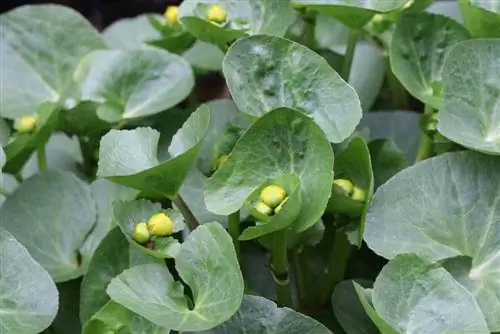
The marsh marigold is generally very robust and resilient. However, under unfavorable conditions it can be affected by one disease or another. These include in particular an infestation with the rust fungus Puccinia c althae or mildew.
Rust fungus Puccinia c althae
- Infestation by this fungus, most common disease of marsh marigold
- Recognizable by yellow and brown, protruding rust spots and pustules (spore storage)
- Grow in the form of nests on the tops of the leaves of the host plant
- In the further course, the entire plant is infected
- Remove and dispose of infected plant parts at the first sign
- Spread of this fungus can be avoided
- Treat plants in the bed with an approved fungicide
- Avoid using fungicides in and around the pond
Mildew
If this plant is affected by powdery mildew, this manifests itself in white, floury leaves. An infestation occurs primarily in June/July. To combat it, cut back affected plants completely and dispose of the clippings in household waste, and under no circumstances in the compost heap. In this case, chemical pesticides should not be used in or on a garden pond.

